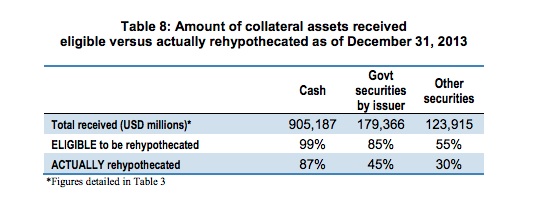This is our second post on the recently published ISDA 2014 Margin Survey. The part of the ISDA survey on collateral rehypothecation was really interesting. It all comes down to a footnote.
From the report:
“….Collateral reuse is common across the industry and serves an important role in reducing collateral funding costs and insuring the global supply of high quality collateral assets is not overwhelmed by demand which could drive up the prices of such assets….”
The table below shows how much cash or securities are eligible to be rehypothecated as well as how much actually is rehypothecated.
Derivatives desks recycle the cash they receive on non-centrally cleared derivatives with a vengeance, using it to hedge and/or finance their positions. Rehypothecating their securities is a bit more complicated — needing to travel through a repo desk to monetize – but that doesn’t stop nearly half of the collateral going out to door. This clearly annoys the regulators who see the resulting collateral chains as a problem.
There was a footnote at the end of the sentence we quoted. It was “WGMR rules will significantly impact rehypothecation.” WGMR stands for Working Group on Margin Requirements. This was a reference to “Element 5: Treatment of provided initial margin” from the Basel Committee on Banking Supervision “Margin requirements for non-centrally cleared derivatives” (September, 2013)
From the BIS paper:
“…Although one firm has received initial margin as collateral, the firm also now bears the risk of additional loss on the initial margin that it has provided to the counterparty if the counterparty defaults, which may offset some or all of the benefits of initial margin received. The risk would be exacerbated if the counterparty re-hypothecates, re-pledges or re-uses the provided margin…”
This was where the “one and done” proposal came from. The concept was that collateral could be rehypothecated only
“…for purposes of hedging the initial margin collector’s derivatives position arising out of transactions with customers for which initial margin was collected and it must be subject to conditions that protect the customer’s rights in the collateral…”
The customer protection part meant that whomever received the collateral needed to segregate it themselves (thus protecting the original collateral poster’s rights) and could not, in turn, rehypothecate it. This seems particularly impractical to us and we question who would really want to take on the segregation burden for someone else’s customer? We wonder what happens if the broker/dealer who rehypothecated the collateral defaults? Will the client’s rights to the collateral be senior, making the exposure unsecured?
In all fairness, this rule might be seen as mimicking what happens in a CCP, where the collateral just sits unused, protecting the CCP in the case of a member default. But attacking the problem by limiting collateral chains seems poorly conceived. Collateral velocity, which is the direct result of collateral chains, is a good thing. In particular we like the analysis on this topic by IMF Economist Manmohan Singh. We’ve written about it frequently, some examples are here, here, and here
The collateral segregation rule was mitigated by proposals to include a high threshold: €50 million. The threshold would all but make the segregation rule non-binding. But recently we’ve heard talk in the market that the threshold might be a lot lower. We can imagine that the optics of a high threshold are not great. Should the threshold have teeth (say, come in at €1 million) and make the rehypothecation prohibition meaningful, there will be a chunk of unsecured liquidity necessary to fund derivatives books. Retail liquidity rich institutions who book their derivatives positions in their banking arms may have a clear advantage.
We should note that only initial margin is in play here. Variation margin is a zero sum game: what goes in, by and large, goes out.


